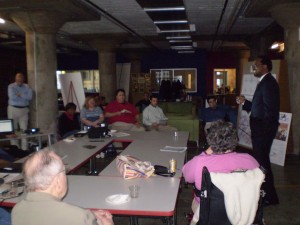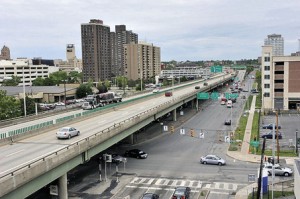Monday night marked the fourth in a series of town hall meetings for NYSTEA. NYSTEA steering committee members traveled to Syracuse to introduce its transportation equity platform, and to hear from residents what issues they were experiencing with regard to transportation access. Syracuse First [1] a local coalition member and the transit union ATU Local 580 [2], co-sponsored the event, attracting a wide range of interests, including transit riders, workers, community groups, and representation from transit agencies and elected officials.
Chris Fowler from Syracuse First was the organizer of the event kicked off the meeting with his transportation vision, “transit policy touches everyone and as we develop a vision for our community’s future we need to make sure as many people as possible are at the table. Equitable, accessible, and inter-modal public transportation options need to be a part of the solution every bit as much as roads and highways do.”
 After an introduction by NYSTEA to concepts of transportation justice, equitable smart growth, and an overview of federal and state policy, the floor was turned over to the locals to have a discussion about what concerns they had about transportation in Syracuse. An issue drawing impassioned responses from both sides was what to do about the dilapidated I-81 [3], which historically cut through the old Jewish and African-American 15th Ward. The city’s sprawl also created many livability issues, and made public transportation difficult.
After an introduction by NYSTEA to concepts of transportation justice, equitable smart growth, and an overview of federal and state policy, the floor was turned over to the locals to have a discussion about what concerns they had about transportation in Syracuse. An issue drawing impassioned responses from both sides was what to do about the dilapidated I-81 [3], which historically cut through the old Jewish and African-American 15th Ward. The city’s sprawl also created many livability issues, and made public transportation difficult.
Transit riders shared many concerns regarding Centro [4](the region’s local transit provider), primarily with the service cuts and fare increases [5] this April, leaving many without access to work and school. Cynthia Wright, a student at Syracuse University, said “Sometimes I take night classes at SU, and there are no night buses to get back home.” Increased wait time at buses, and the need to walk long distances to catch buses where service had been cut was a palpable hardship felt by many riders. Ridership on Centro buses is increasing due to high gasoline prices, yet single-rider fares have gone up 60% this year, a great financial burden to many of Syracuse’s transit dependent.
 Bus drivers sympathized with the riders, though as the public face of the organization, resented receiving the brunt of complaints for issues that they had no control over. Many in attendance discussed the possibility of organizing a grassroots campaign aligning the workers and riders, similar to other efforts like the Bus Riders Union [6] in Los Angeles.
Bus drivers sympathized with the riders, though as the public face of the organization, resented receiving the brunt of complaints for issues that they had no control over. Many in attendance discussed the possibility of organizing a grassroots campaign aligning the workers and riders, similar to other efforts like the Bus Riders Union [6] in Los Angeles.
Duly emphasized was the funding gap Centro was experiencing from the state and federal levels [7], leading to service cuts, and that they are the end point of a lot of decisions made elsewhere. Pressure needs to be placed on Albany and D.C. to continue to and enhance funding for public transportation, so that costs aren’t passed on to riders. All agreed that improvements in public transportation would have concrete benefits to livability in Syracuse. NYSTEA looks forward to continuing this partnership in Syracuse. We greatly appreciate our local partners and all the participants of last night’s event.